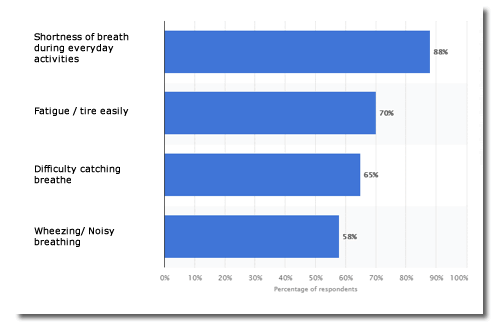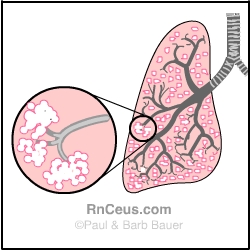Percentage of individuals in the U.S. with Chronic Obstructive Pulmonary Disease who experienced select symptoms as of 2020

Source: Symptoms experienced by individuals in the U.S. with COPD in 2020 Published by John Elflein, Nov 19, 2020
Emphysema: Assessment
Emphysema is a chronic obstructive pulmonary disease. Chronic obstructive pulmonary disease (COPD) refers to a group of progressive respiratory diseases, including both chronic bronchitis and emphysema.
Chronic Obstructive Pulmonary Disease (COPD) is a lung disease that causes obstructed airflow in the lungs and results in breathing problems. COPD is used to describe such lung diseases as emphysema, chronic bronchitis, and severe asthma.
In 2019, COPD was the third leading cause of death worldwide, accounting for around 3.23 million deaths that year In nearly 8 out of 10 cases, COPD is caused by exposure to cigarette smoke. Other environmental exposures (such as those in the workplace) may also cause COPD. (healthy People 2020)
Genetic factors strongly influence the development of the disease. For example, not all smokers develop COPD.4 Quitting smoking may slow the progression of the disease. Women and men are affected equally, yet more women than men have died of COPD since 2000.Currently more than 25 million people6,7 in the United States have asthma. Approximately 14.8 million adults have been diagnosed with COPD, and approximately 12 million people have not yet been diagnosed. The burden of respiratory diseases affects individuals and their families, schools, workplaces, neighborhoods, cities, and states. Because of the cost to the health care system, the burden of respiratory diseases also falls on society; it is paid for with tax dollars, higher health insurance rates, and lost productivity. Annual health care expenditures for asthma alone are estimated at $20.7 billion.
This statistic shows the percentage of individuals in the U.S. with Chronic Obstructive Pulmonary Disease (COPD) who experienced select symptoms as of 2020. It was found that 88 percent of those with COPD stated they had experienced shortness of breath during everyday activities.
Percentage of individuals in the U.S. with Chronic Obstructive Pulmonary Disease who experienced select symptoms as of 2020
Source: Symptoms experienced by individuals in the U.S. with COPD in 2020 Published by John Elflein, Nov 19, 2020 |
In the early phase of COPD, patients may experience wheezing, chronic productive cough, and minimal shortness of breath. However, the person's quality of life decreases as COPD progresses. Later symptoms include increasing dyspnea, progressive exercise intolerance, periodic respiratory infections that occur with increasing frequency and severity, increasing cough, and purulent sputum.

Emphysema: Caused by progressive destruction of pulmonary connective tissue, usually by an inflammatory process and/or cigarette smoking. Air sacs distal to terminal bronchioles become permanently enlarged, and interalveolar walls are destroyed. The result is airway obstruction, particularly upon expiration. Lungs become hyperinflated, and lung volume increased. The diagram above shows tissue destruction throughout the lung, and overdistended alveoli with destruction of septa.
| Assessment findings include: | |
|
Inspection |
|
|
Palpation |
|
|
Percussion |
|
|
Auscultation |
|
Emphysema is a chronic obstructive pulmonary disease (COPD). Visit the "therubins" website http://www.therubins.com/illness/respcopd.htm for indepth information about COPD.
Instant Feedback:
© RnCeus.com